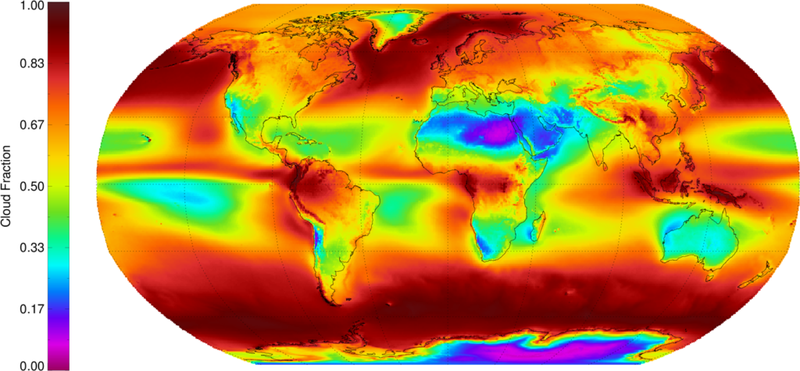Cloud feedback has been the largest source of uncertainty in estimating global mean surface temperature increase with global warming for more than twenty years. Water vapour is a greenhouse gas which acts as an insulator of the earth to the direct heat and cold from space, and helps to keep the earth’s temperature stable. As represented by the Clausius-Clapeyron relation, more water vapor will be present per unit volume at elevated temperatures. This and other basic principles indicate that warming associated with increased concentrations of the other greenhouse gases also will increase the concentration of water vapor. Because water vapor is a greenhouse gas, this results in further warming and so is a “positive feedback” that amplifies the original warming. Clouds are a condensed/sublimated form of water and act similarly, but they also reflect sunshine and reduce the amount of energy that the earth absorbs. About half of the reflected solar radiation by the earth is due to clouds. The involvement of various processes, including the compensating radiative effects and changes in response to climate change, make understanding cloud feedback mechanisms challenging. Long-term satellite observations of the earth radiative energy budget and clouds will help us understand responses of the earth to changes in greenhouse gases, and provide observational constraints to cloud feedback.

Figure 1: Fraction of clouds over the world, from CCI data (1981-2014 average).
So how have satellite observations contributed to improving the understanding of clouds and climate change? Two US-led global earth radiation budget observation initiatives, the Earth Radiation Budget Experiment (ERBE) and the Clouds and the Earth’s Radiant Energy System (CERES), are commonly used to provide reference values for climate models. Cloud data are available from operational weather satellites for the last 30 years. In the last ten years increasingly sophisticated research instruments such as cloud radars are providing data for the three dimensional structure of clouds. These data help us to assess climate models and identify errors and common biases in modelled cloud. For example a recent study showed that models that reproduce different type of clouds more accurately compared to observations tend to have higher climate sensitivities.
Differences between modelled and observed cloud are in part due to the represent cloud phenomena, but sensors have a threshold to be able to detect clouds. Clouds which are thinner/smaller than a threshold are not captured in the observations. A group in the cloud feedback research community have developed tools (for radiative transfer routines in climate models) to emulate the threshold so that they can estimate how modelled cloud would be observed by satellites. It is since introducing this ‘satellite view’ that climate modellers have been able to compare modelled cloud with the observations more robustly. Now these tools are essential for the climate model community to carry out model inter-comparisons for climate change simulations.
The European Space Agency (ESA) has established the Climate Modelling User Group (CMUG), to place a climate system perspective at the centre of its Climate Change Initiative (CCI) programme, and to provide a dedicated forum through which the Earth Observation Data Community and Climate Modelling Community can work closely together. The CCI data sets combine the past independent satellite observations and will provide long-term cloud data for studying long-term changes in cloud and a long-term reference dataset will be required to evaluate the data. The US satellite mission, Climate Absolute Radiance and Refractivity Observatory (CLARREO), is planned to provide such a dataset for radiative energy.
The Keeling Curve provides the longest available observational record of carbon dioxide measured at NOAA’s Mauna Loa observatory from 1958 to the present and is widely recognized as a definitive record of mankind’s impact on the Earth’s atmosphere, linking rising levels of carbon dioxide from man’s burning of fossil fuels to the warming of the planet. The observational instruments are continuously calibrated to provide a stable long term record. We need to expand efforts in satellite observations to the earth energy budget and clouds to provide a high quality dataset over similarly long time periods. Such a time series would improve our understanding of climate change and provide clear evidence of a global feedback.
About the author

This article was produced in January 2016 by Yoko Tsushima. Yoko is a senior scientist at the Met Office (UK), explains the significance of CCI cloud satellite data sets for cloud modelling.

